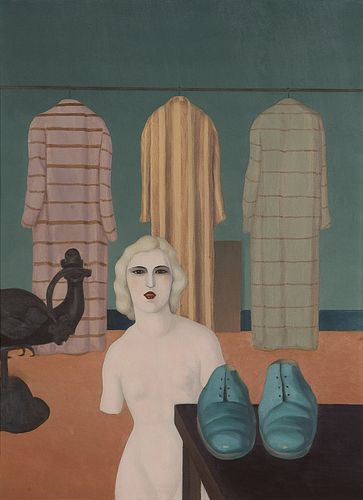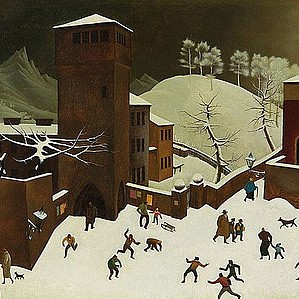ALBERT REUSS (Vienna 1889 - 1975 Mousehole, Cornwall) The blue Shoes, 1948
Lot 171
Estimate:
EUR€4,000 - EUR€8,000
$4,301.08 - $8,602.15
Absentee vs Live bid
Two ways to bid:
- Leave a max absentee bid and the platform will bid on your behalf up to your maximum bid during the live auction.
- Bid live during the auction and your bids will be submitted real-time to the auctioneer.
Bid Increments
| Price | Bid Increment |
|---|---|
| EUR€0 | EUR€10 |
| EUR€100 | EUR€50 |
| EUR€700 | EUR€100 |
| EUR€1,000 | EUR€200 |
| EUR€3,000 | EUR€300 |
| EUR€3,600 | EUR€400 |
| EUR€4,000 | EUR€500 |
| EUR€7,000 | EUR€1,000 |
| EUR€16,000 | EUR€2,000 |
| EUR€30,000 | EUR€3,000 |
| EUR€36,000 | EUR€4,000 |
| EUR€40,000 | EUR€5,000 |
About Auction
By Widder Auctions
May 19, 2022
Set Reminder
2022-05-19 11:00:00
2022-05-19 11:00:00
America/New_York
Bidsquare
Bidsquare : Masterpieces
https://www.bidsquare.com/auctions/widder-auctions/masterpieces-9287
Masterpieces of classical modernism by Austrian and international artists coming up for auction in Vienna on May 19th Widder Auctions office@widderauktionen.com
Masterpieces of classical modernism by Austrian and international artists coming up for auction in Vienna on May 19th Widder Auctions office@widderauktionen.com
- Lot Description
ALBERT REUSS*
(Vienna 1889 - 1975 Mousehole, Cornwall)
The blue Shoes, 1948
oil/canvas, 63 x 47,5 cm
verso titled and dated "the blue shoes" 1948
Provenance: Fine Arts Widder, European private collection
ESTIMATE °€ 4.000 - 8.000
Austrian painter and sculptor of the 20th century. Representative of exile art, belongs to the so-called lost or forgotten generation. Came from a Jewish family and initially worked as an actor. As a painter self-taught, exhibited from the 1920s in the Vienna Secession, the Hagenbund and the Würthle Gallery. From 1932 member of the Hagenbund. From the mid-1930s also sculptor, 1935 stay at Bedfordshire estate in England. 1938 emigration via London to Mousehole in Cornwall. His wife ran the gallery ARRA Gallery with artists such as Jack Pender or Alexander Mackenzie of the artist colony St. Ives. Lifelong friendship with gallery owner Jacques O'Hana. Early influences of Gustav Klimt and Egon Schiele, then influences of expressive Carinthian painting. After emigration, development of style in the direction of New Objectivity and Surrealism. Landscapes with figures and individual objects in increasingly cool and restrained colors and monochrome surfaces. Colorfulness, mysteriousness and the static, frontal posture of the female torso comparable to works by Paul Delvaux. Composition and mood, calm, melancholy and contemplation comparable similar in the works of Josef Floch.
Albert Reuss, son of a Jewish butcher (named Reiss) in Budapest, went to Vienna against his father's wishes at the age of 18 to become an artist. He studied the works of the great masters in the Viennese museums, but remained self-taught. His style in those years was expressive, with an impasto application of paint and a lively color palette. In 1930 a patron made it possible for him to spend a year on the French Riviera. The landscapes, still lifes and figure paintings created there were exhibited in 1931 in the Würthle Gallery in Vienna, where Reuss had already shown a collective exhibition in 1926, at that time under the patronage of the Society for the Promotion of Modern Art. In 1932 the artist became a member of the Hagenbund, but emigrated to England in 1938 because of increasing pressure from the Nazi regime. There he exhibited in provincial galleries with little success and, due to the indifference of the gallery owners and the public, retreated to the countryside in Cornwall, where he continued to work intensively on his paintings. His pictures became increasingly heavy in content and revealed his mental state at this time. He himself called the fruits of his labor "images of loneliness". In 1975 these works were shown at the BAWAG Foundation in Vienna.
PLEASE NOTE:
The purchase price consists of the highest bid plus the buyer's premium, sales tax and, if applicable, the fee of artists resale rights. In the case of normal taxation (marked ° in the catalog), a premium of 24% is added to the highest bid. The mandatory sales tax of 13% is added to the sum of the highest bid and the buyer's premium. The buyer's premium amounts to 28% in case of differential taxation. The sales tax is included in the differential taxation. - Shipping Info
-
Shipping
We will send you the invoice shortly after the auction. As soon as we have recieved the amount, the art can be picked up at Johannesgasse 9-13, 1010 Vienna. Please note that the buyer is responsible for pick-up and shipping of the lot.
Should you wish to ship your items, please contact: Mailboxes Email: oper@mbe-co.at Tel: 01 5128855
Please note that storage fees may apply, should the pieces not be picked up within 14 days after invoicing for domestic and 28 days for international transportation.
Our team will be happy to assist you with any further information at office@widderauktionen.com or at 0043 676 555 66 10.
-
- Buyer's Premium



 EUR
EUR CAD
CAD AUD
AUD GBP
GBP MXN
MXN HKD
HKD CNY
CNY MYR
MYR SEK
SEK SGD
SGD CHF
CHF THB
THB













